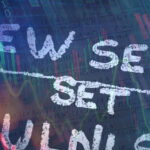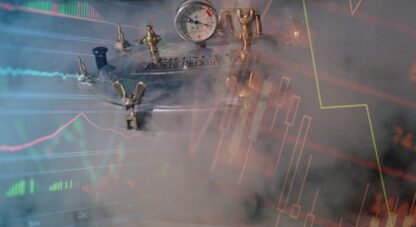Staring Down the Bust
This long holiday weekend inspires a long HAI. Make no mistake, these are significant times. This is a hot, not healthy, economy. We have experienced the boom, and now the bust looms. We are facing what appears to be something akin to a Frankenstein economic cycle.
There are many reasons for this. The Covid shutdown of the economy was entirely unnatural and had an unprecedented impact in almost completely halting production. The reopening was also dramatic, equally unnatural, and just as unprecedented in terms of the sudden rebound on the demand side. In addition, the direct injections of trillions worth of monetary and fiscal stimulus into a nearly shut down economy was also completely unprecedented and a recipe for serious trouble. The rate of inflation increasing from zero to an over 40-year high in just two years is one obvious manifestation of the trouble. Another, largely underappreciated, manifestation of trouble is in the fact that the cumulative impact of this cycle’s massive and consequential distortions will likely contribute to an exceptionally short cycle where the extreme boom is mirrored by an equally extreme bust.
The spark of inflation has fully matured into a raging inferno. As long as that inflation burns at a faster rate than wages are increasing, and the savings rate, now below pre-Covid trend, continues to decline, the consumer-driven economy is in a losing race against time. This hot economy is not producing the sort of widespread prosperity that builds the strong foundations of sustainable economic health. Rather, the consumer in this economy is running the hamster wheel. As a result, there is no healthy, sustainable forward progress, and critical fatigue is only a matter of time. Again, unhealthy, and unsustainable dynamics are at work on the consumer side of the equation. This carries great negative consequence.
In our Frankenstein Covid-era economic cycle, the particular nature of the demand rebound is unique. In a more “normal” recession, economic demand recovers slowly, in an orderly fashion, according to a natural logical progression. In a healthy recovery after a recession, pent-up demand, perhaps with an assist from loosened monetary policy, finally initiates the green shoots of a demand uptick. A little more demand incentivizes a little more production. To increase production, a little more labor is needed. More work hours and new jobs means money in the pockets of these workers who are, of course, consumers. These consumers are now in a better financial condition. They increase their consumption, and the virtuous cycle goes full circle as they contribute to further increases in aggregate economic demand. This is an extremely simplified characterization of the economic expansion engine, but hopefully the point is comprehensible.
This type of expansion is healthy. It starts from healthy foundations and builds naturally upon its own strength and at its own orderly pace. This allows companies to increase production and increase hiring levels at a rate fairly well calibrated to the increased level of demand they are receiving. A suitable balance is attained between the growing level of demand and both production and hiring growth. Profits are produced and both corporate and consumer balance sheets improve.
This process is typically a slow burn that plays out over a long time and can facilitate a lengthy economic expansion. The high unemployment rate always seen at the end of a recession represents a large pool of available workers that act as a substantial source of fuel for the healthy expansion process. As those workers are hired into the expanding economy, the virtuous cycle plays out, the economy grows, and the unemployment rate gradually falls. As this process plays out over time, eventually the labor market settles towards full employment. As we near full employment, and the unemployment rate drops toward historical trough levels, the fuel for this expansion process is reduced, growth slows, and the economic cycle is near peak.
In our last economic expansion cycle, the peak unemployment rate was 10% in 2009 in the wake of the great financial crisis. As the economy recovered and expanded, the unemployment rate gradually fell from the high in 2009 to an eventual low of 3.5% in 2020. Again, this exemplifies the slow burn, over 11 years, of this cyclical fuel for economic growth. Over the last 60 years, the most significant low levels of trough unemployment reached before the cycle turned and we headed toward recession were 3.4%, 3.8%, 4.4%, and 3.5%. From these low levels of unemployment, economic growth slowed, jobs were lost, and we headed into recession.
The significance of all of this to our current bizzarro cycle is extreme. The labor market dynamics with our current cycle are entirely different and completely unprecedented. There is absolutely no slow-drip long-term labor market growth engine at work this cycle. We pulled it all forward in a two-year job growth explosion. Prior to Covid, the economy was already decelerating, leading economic indicators falling, yield curves had inverted, and the unemployment rate had dropped to trough levels at 3.5%. Even without the artificial Covid recession, a strong case can be made that we were already on our way to recession.
So, the story of the post-Covid recovery starts with the unnaturally extreme rebound in demand caused by the sudden transition from lockdown to reopening. Rather than the measured, slow drip, building of economic demand seen in a more typical cycle, demand flooded back into the economy. Adding an insane kick to that flood of demand was the trillions of newly printed money placed directly into the hands of the consumer. There was no way that, after being essentially off-line, the ramping up of production was going to be able to keep up with this sudden tidal wave of demand.
With the combined impact of intense monetary inflation and way too much money chasing way too few goods, it’s no wonder inflation has exploded. So, with the unnatural and unprecedented surge in demand, production has been in an adrenaline-fueled catch-up mode ever since reopening. As a result, employment has raced right back to pre-Covid levels as the unemployment rate has performed the largest collapse in American history. In two years, the unemployment rate has fallen from 15% all the way back to 3.6%. At 3.6%, we are already, in just two years of this growth cycle, at historical trough levels of unemployment. While the Fed projects to maintain this low level of unemployment for the next several years, that would be an accomplishment never seen before in history. Over any timeline greater than a year, history instructs that the unemployment rate will move higher from these levels.
We have pulled forward the better part of a decade of job growth fuel into the last two years. Add the impact on demand from the trillions in stimulus checks and you have a perfect storm of economic demand. Looking back, one can see the boom, looking ahead, the picture of potential bust emerges with ever greater clarity.
With a onetime stimulus party over, at least for now, and the demand effect from an expanding labor market dramatically pulled forward, a serious growth slowdown is upon us. When the demand sugar-high really begins to fade, we will look an awful lot like the pre-Covid economy that was already very late cycle and likely headed toward recession. Some things have changed, however. We have far more debt in the system now, and inflation, a non-factor in the pre-Covid cycle, is now raging at a 40-year high.
With inflation outpacing wages, and the savings rate dropping below pre-Covid trend, the consumer has been under the gun. For the consumer, inflation has sapped the usual beneficial effect of an expanding labor market. Rather than the normal consumer health benefit, as the economy has surged, consumer sentiment has plunged to lows far deeper than Covid lockdown levels. Various consumer sentiment measures from the University of Michigan and the Conference Board are already at recessionary levels.
It’s not just the consumer singing a recessionary tune, however. Also raising eyebrows this week, the latest Bank of America global Fund Manager Survey (FMS) went from bad to apocalyptic. The latest survey of the professional class revealed that global growth optimism has never been worse, and that, not surprisingly, recession is the cohort’s #1 concern. To emphasize, global growth optimism is now lower than at any point during the darkest depths of the Great Financial Crisis. By contrast, presently, the BofA index is already breaking uncharted recessionary ground before the first real shots have even been fired. In a note to clients, BofA chief investment strategist Michael Hartnett wrote that clearly, at this point, “Economic growth and profit expectations are recessionary.” The BofA strategist, who assumes an imminent recession if real wages stay negative into summer, referred to the disconnect between global growth optimism and current equity allocation as “staggering,” and said that, as of yet, “equities are nowhere near recessionary close-your-eyes-and-buy levels.” Hartnett proceeded to describe the stock market slump earlier in the year as just an “appetizer, not the main course of 2022.”
Morgan Stanley chief equity strategist Michael Wilson also spots the growth problem ahead and shares Hartnett’s view on current equity market complacency. Wilson said this week that, “stocks have yet to price a looming sharp slowdown of the economy.” If equity markets break down further, as expected, the ensuing negative wealth effect will add another substantial driver accentuating and accelerating a growth bust.
Also singing loud and proud in the recessionary chorus this week, the National Federation of Independent Business (NFIB) released their latest monthly small business survey. It’s not good. According to the NFIB, owners expecting better business conditions over the next six months decreased to the lowest level ever recorded in the 48-year history of the survey. According to the report, small business owners cite inflation as their number one problem. The report additionally revealed that, in response, the percent of owners raising their average selling prices also increased to the highest reading in the survey’s history. Given the economic mess out there at present, it seems increasingly likely that these small businesses will continue to raise their prices right into the teeth of the eventual demand destruction the higher prices will cause.
When the endless surge of increasing consumer prices finally overwhelms the weakened consumer and widespread demand destruction takes hold, the growth time bomb will blow, and the bust cycle will accelerate in earnest. This week, we received some hints that that moment may be rapidly approaching. This week the Bureau of Labor Statistics released the latest monthly numbers for both the Consumer Price Index and the Producer Price Index. Both headline numbers were hotter than expected and thoroughly scorching. Headline CPI was 8.5% y/y, and headline PPI increased by an all-time record 11.2% y/y. The more interesting data, however, was in the “core” reading that excluded the impact of food and energy. Core CPI increased to 6.5%, but came in lower than expected. The prime contributor to the lower than expected reading was the impact of a 3.8% decline in used car prices. The “core” PPI measure however, came in at a whopping 9.2%, massively exceeding the 8.4% estimates.
While many analysts and probably shell-shocked former team-transitory Fed members cheered the report as marking the peak of inflation, a potentially more significant alternative interpretation was also available. Since the start of the inflation surge, PPI has outpaced CPI. That makes sense. It’s the producers who are on the front lines of the inflation battle. They have no choice but to pay the market price for their needed goods and materials. On consumer prices, the CPI reflects, to a much larger extent, the ability of businesses to pass through a lesser extent of price increases to the end consumer. They can elect to eat more of the rising input costs than they pass to the consumer if they think they may lose more in lower sales volume (demand destruction) than they recoup from passing on higher costs. Since inflation began to skyrocket, CPI has been lower than PPI, but CPI has been chasing PPI higher and gaining ground as companies have been able to pass on more costs to the consumer. Well, this week was the most significant sign yet that that may be changing and that demand destruction may be starting to inhibit companies from passing on costs. If so, it may mark a very significant acceleration point in the economic down cycle. This will have to be closely watched.
As noted, the decline in used car prices was the standout underperformer within the core CPI reading, and the industry could be a canary in the coal mine warning of demand destruction. Sure enough, adding significant credibility to the thesis, this week, CarMax, the nations largest retailer of used cars, revealed that the number of used vehicles they sold for the quarter ending on February 28th declined 6.5%. Record high used car prices and surging interest rates were blamed for sparking demand destruction and a buyers strike. On the earnings conference call, CarMax CEO Bill Nash remarket that, “From an affordability standpoint, you’ve got interest rates going up, inflation… there’s just a lot weighing on the consumer right now… the lower credit spectrum customer, certainly, we feel affordability has maybe often priced them out of the market.” Mr. Nash’s comments should be of concern to the economically critical housing market as well.
With housing prices at all time highs, and the now surging 30-year mortgage rate surpassing decade highs, the National Association of Realtors (NAR) has pointed out that housing affordability has now reached some of the worst levels on record. Similarly, economists at Bank of America recently stated that the ongoing plunge in housing affordability is at a record pace. NAR senior economist Nadia Evangelou estimates that millions of Americans have been priced out of the housing market just since the start of the year. She has nine million would-be buyers now priced out, three million of which are millennials. Again, critical issues with the potential impact of demand destruction are now in play and will need to be closely monitored going forward.
Have no fear, however, the Fed is here! This week, Cleveland Fed president Loretta Mester said in a CBS interview that by making home, auto and other loans more expensive, Fed interest rate increases and other actions “will help reduce excess demand, which is outpacing constrained supply, and bring price pressures down.” Mester said she was “optimistic” the current economic expansion and strong job market would continue despite tighter monetary policy and the expected resulting reduction of economic demand. Mester said, “I think we can reduce excess demand relative to supply without pushing the economy into recession.”
Maybe a year ago, Loretta Mester’s analysis and “optimistic” forecast might have seemed more plausible. Still a stretch, but at least more immediately plausible. At this point, however, in the context of this freak show cycle, Mester’s views seriously strain credulity. Anything is possible, of course, and Mester may be absolutely correct. While hope, however, springs eternal, when examining the specific dynamics playing out presently in this cycle, Mester’s take seems woefully naïve, misaligned with reality, and out of touch.
David Rosenberg is one of the most respected economists in the business. His analysis appears far more plausible and squares much more convincingly with the data. This week, Rosenberg said, “the recession is staring us in the face.” Rosenberg went on to say that “we should all be prepared for the fact that the only way you can break the back of this sort of inflation is through a recession.”
This week, in an interview with Bloomberg, former Treasury Secretary Larry Summers agreed with Rosenberg and offered his opinion that a hard landing in a recession is the most likely outcome from our current predicament. As Summers points out, “there has never been a moment when inflation was above 4% and unemployment was below 5% when we did not have a recession within the next two years.” As has been laid out already, in addition to the fact that we currently have even higher inflation and a lower unemployment rate than Summers cites to make his point historically, a number of other factors are also conspiring to pull the two year recession window even more near-term. According to Summers, the strong likelihood is that, “at the end of the day, we’re going to see a fairly hard landing.”
If this unbelievably compressed, incredibly unhealthy, flash-in-the pan adrenaline cycle was not already perfectly teed up to descend dramatically into decline, the added push from looming hawkish Fed policy implementation and its inevitable contribution to demand destruction should certainly be a very effective helping hand. While that seems straightforward to me, voices within the greater Fed family offer two different visions for how near-term events may unfold. Like Loretta Mester, Fed Chairman Jay Powell expresses his optimism in this economy’s ability to withstand tighter monetary policy. He concedes, nevertheless, in the understatement of the year that, “No one expects that bringing about a soft landing will be straightforward in the current context.” On the other side of the spectrum, Former Federal Reserve Bank of New York president Bill Dudley says the Fed has made a U.S. recession “virtually inevitable.”
In recent weeks, HAI has attempted to highlight untenable and unsustainable political and economic policies as the primary underlying root cause of our ever-deepening present predicament. There is a far bigger story playing out here than merely whether or not we are heading into a recession. Increasingly, the story is ever more about the untenable and unsustainable nature of our theoretical economic framework and the policies derived therefrom.
Our centrally managed and ever more artificially constructed economy is fragile, inherently unstable, and unsustainable in the long run. In our modern era of activist central banks, economic orthodoxy has increasingly become defined by large scale and determined efforts on the part of policymakers to manage, control, and direct the economy. These policy interventions are rarely according to the dictates of sound free-market economics, but rather flow from Keynesian and Modern Monetary theory and are usually applied in the service of expedient short-term objectives. They manipulate, increasingly distort, and over time destabilize the creative natural forces identified long ago as the miracle of the free-market based economic system. In doing so, reckless shortsighted policies threaten to catastrophically burden and undermine the system’s proven ability to bear fruit. As F.A. Hayek warned, “…unless we mend the principles of our policy, some very unpleasant consequences will follow which most of those who advocate these policies do not want.” The ill effects of these policies are now mounting at an alarming rate. The massive and rapid accumulation of unproductive debt in all segments of the economy dramatically destabilizes the economic system and negatively constrains our future potential economic growth. At this point, our policies are clearly starting to foster dramatically accentuated volatile boom-bust cycles over increasingly shortened timelines. In continued adherence to specious economic theory and policy, we are undermining trust in the economy, financial system, central bank stewardship, and in the fiat currency system.
As Thomas Sowell rightly points out, “Nothing is easier than to have good intentions, but, without an understanding of how an economy works, good intentions can lead to disastrous consequences…” Here, Mr. Sowell says it all. Good intentions are a wonderful and necessary inspiration, but they must be channeled through an understanding of economics to determine what works in the long run. That means tenable and sustainable economic policies that, while absolutely born of good intentions, crucially reflect an understanding of how our free-market system beneficially operates. It also requires the patience to allow good economic policies that optimize the health, vitality, and functioning of the free-market system to bear fruit benefiting us all. Wise policy innovations aimed at systemic improvement are most welcomed and encouraged in this context of wisdom and economic understanding.
The Keynesian inspired policy innovation, activism, and serial intervention of our modern era of central banking, however, falls woefully short of meeting this standard. This policy approach is borne of impatience and cynically aims to secure today’s immediate desire at the expense of tomorrow’s predicament. As a result, to paraphrase Henry Hazlitt, the obvious perpetual risk is that today is the tomorrow we were warned about yesterday. At this point, we may well be standing on the verge of harvesting the unwanted results of an outsized dose of the negative accruing consequences keen observers have been flagging for decades.
Gold appears to be alerting us, too, and confirming the extraordinarily elevated risks inherent in our modern moment. Since closing the gold window, the yellow metal has been watching and reacting to the modern monetary developments of recent decades. Fallacious economic theory and its implementation through policy have caused the price of gold, as insurance, to rise dramatically over time. The radical economic policy events surrounding the Covid crisis represented a staunch commitment to the theoretical policy “prescriptions” of modern central banking. Covid era economic policy initiatives thrust us considerably further down a one-way economic path that ultimately terminates in “lose-lose” policy optionality.
In more “normal” environments, when the threat of policy error and systemic risks are less acute than at present, gold typically behaves like a more traditional “financial instrument” with prices reacting to numerous factors. Historically, a strong and strengthening U.S. dollar, sharply rising interest rates, or a Federal Reserve swinging dramatically into full-on hawk mode would be extremely likely to send gold prices into a swoon. Not so today. In recent months, gold has been on the rise, testing all-time highs, and is poised to break out to the upside toward uncharted territory. Testifying both to the high-risk nature of our present monetary moment and gold’s recognition and singular preoccupation with it; gold has been ascending in spite of stiff headwinds courtesy of the dollar, interest rates, and a hawkish Fed working in coordinated unison. Upon close examination, in context, the unprecedented behavior of the yellow insurance instrument carries a clear suggestion. The market is attuned to the high risk of a tempest, and the storm is bearing down.
To fully navigate out of this mess, the Fed will have to restore its credibility, snuff out inflation, stick the promised featherbed landing for the economy, and address the faulty theoretical underpinnings of the monetary policies that stranded them in a minefield to begin with. Gold will be watching.
Weekly performance: The S&P 500 was down 2.13%. Gold was up 1.51%, silver was higher by 3.55%, platinum gained 1.91%, and palladium lost 2.67%. The HUI gold miners index was up 2.61%. The IFRA iShares US Infrastructure ETF was up 0.96% on the week. Energy commodities were up big. WTI crude oil gained 8.84%, while natural gas was up 16.28% on the week. The CRB Commodity Index was up 4.60%, while copper was flat, lower by 0.04%. The Dow Jones US Specialty Real Estate Investment Trust Index was down 1.47% on the week, while the Vanguard Utilities ETF (VPU) was off 1.26%. The dollar was higher by 0.57% to close the week at 100.33. The yield on the 10-year Treasury jumped by 11 bps to end the week at 2.83%.
Best Regards,
Morgan Lewis
Equity Analyst & Investment Strategist
MWM LLC

















